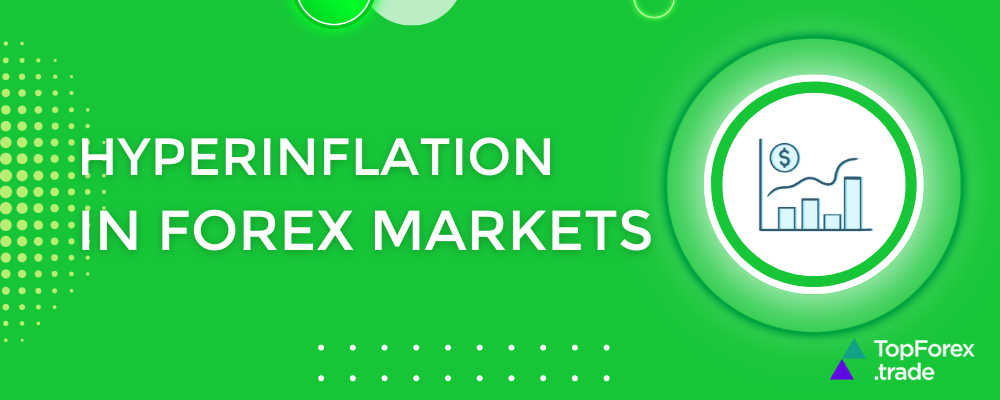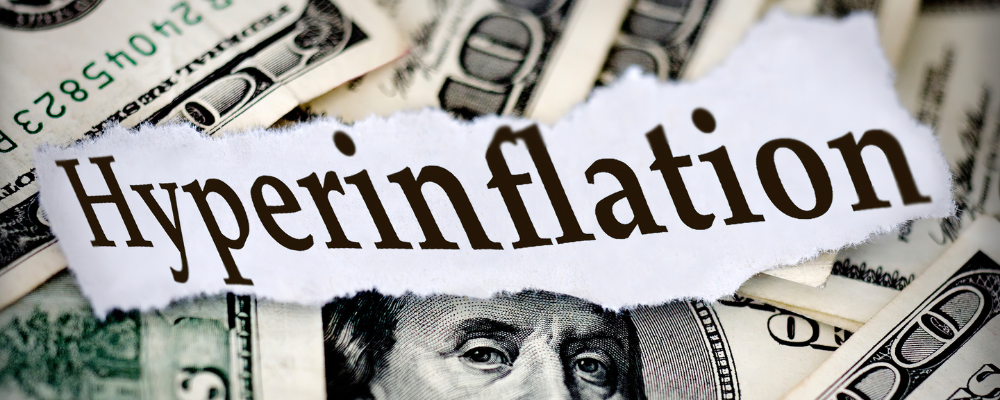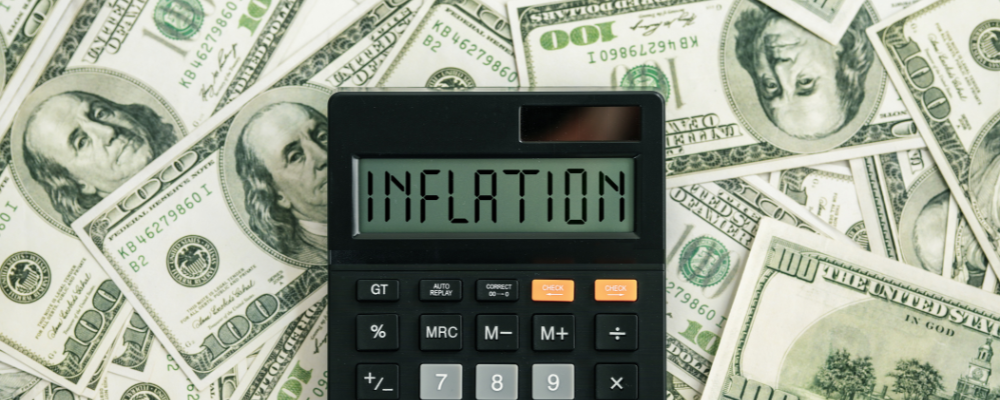Navigating hyperinflation: strategies for Forex traders

Hyperinflation, with its rapid and uncontrollable price surges, presents a formidable challenge for Forex traders. This economic turmoil can drastically impact currency values and throw even the best trading strategies off course. However, for those who understand and can navigate this volatile landscape, hyperinflation also offers unique opportunities. In this article, we’ll break down what hyperinflation is, why it happens, and how it affects the Forex market. More importantly, we’ll share practical strategies to help forex traders not only cope with hyperinflation but also find ways to profit from it.
Understanding hyperinflation: causes and examples

Hyperinflation is an extremely rapid and uncontrollable rate of inflation, where the prices of goods and services increase exorbitantly in a very short period. Unlike typical inflation, which is usually gradual and manageable, hyperinflation can render a country’s currency nearly worthless, eroding purchasing power and destabilizing the economy.
Hyperinflation occurs due to several factors:
- Excessive money printing: When a government prints an excessive amount of money to finance its spending without corresponding economic growth, it leads to an oversupply of money, drastically reducing its value.
- Loss of confidence: A loss of confidence in a country’s currency or government can lead to hyperinflation. When people start doubting the currency’s value, they rapidly exchange it for more stable assets, further devaluing the currency.
- Supply shocks: Severe disruptions in the supply of goods, such as during a war or natural disaster, can lead to shortages and skyrocketing prices, contributing to hyperinflation.
- Debt and deficits: Large national debts and deficits can prompt a government to print more money to cover its obligations, leading to hyperinflation.
Examples of hyperinflation:
- Germany (Weimar Republic), 1920s: After World War I, Germany faced reparations payments and economic troubles. To cope, the government printed more money, leading to hyperinflation. Prices doubled every few days, and by late 1923, the exchange rate was 4.2 trillion marks per US dollar.
- Zimbabwe, 2000s: Zimbabwe’s economy collapsed due to land reforms and economic mismanagement, leading the government to print money excessively. Hyperinflation peaked in 2008, with inflation rates reaching 89.7 sextillion percent per month, making the Zimbabwean dollar virtually worthless.
- Venezuela, 2010s-present: Political instability, economic mismanagement, and falling oil prices led to hyperinflation in Venezuela. By 2018, the inflation rate exceeded 1,000,000%. The Venezuelan bolívar lost its value, leading to severe shortages of basic goods.
Strategies for Forex traders during hyperinflation

Navigating hyperinflation can be particularly challenging for forex traders. Here are some strategies to manage the risks and potentially find opportunities in hyperinflationary environments:
- Diversification: Spread investments across multiple currencies to reduce exposure to the collapse of any single currency. For instance, during Zimbabwe’s hyperinflation crisis, diversifying into currencies like the US dollar or South African rand would have helped mitigate the impact of the Zimbabwean dollar’s devaluation.
- Focus on stable currencies: Trade and hold currencies that are typically more resilient to economic shocks, such as the US dollar, Euro, or Swiss Franc. For example, during Venezuela’s hyperinflation, holding and trading in these stable currencies would have provided some protection against the rapid depreciation of the Venezuelan bolívar.
- Hedge against inflation: Utilize financial instruments such as options, futures, and forward contracts to hedge against hyperinflation. For example, traders could use futures contracts on currencies or commodities to lock in prices and manage exposure to currency volatility.
- Stay informed: Regularly monitor news, economic reports, and central bank announcements to stay updated on the latest developments. For instance, understanding the economic and political factors driving hyperinflation in Venezuela could have provided insights for making more informed trading decisions.
- Technical analysis: Employ technical analysis to identify market trends and potential turning points. During periods of hyperinflation, such as in Weimar Germany, using technical indicators and charts would have helped traders anticipate and react to rapid changes in currency values.
- Short selling: If a currency is expected to depreciate further, consider short selling. For instance, during Zimbabwe’s hyperinflation, traders who shorted the Zimbabwean dollar could have benefited as its value plummeted.
- Utilize safe-haven assets: Invest in assets like gold, which often retain value better than fiat currencies during economic turmoil. For example, gold prices surged during periods of hyperinflation in the 1970s and 1980s, providing a hedge against currency devaluation.
Hyperinflation presents significant challenges, but with the right strategies, forex traders can manage the volatility and find opportunities. By diversifying investments, focusing on stable currencies, employing hedging techniques, staying informed, using technical analysis, and considering safe-haven assets, traders can navigate the risks and potentially capitalize on the opportunities in hyperinflationary environments.
Top Forex brokers for handling hyperinflation
Navigating the turbulent waters of hyperinflation requires Forex traders to partner with reliable and robust brokers. This review highlights the top forex brokers that excel in providing the tools, security, and services needed to handle hyperinflationary conditions effectively. These brokers offer strong regulatory oversight, advanced trading platforms, diverse currency pairs, and comprehensive risk management tools, ensuring traders can adapt and thrive even in the most volatile economic environments.
XTB FX trading
XTB is a premier choice for Forex and CFD trading, with a significant global reach spanning over 190 countries. Recognized for its emphasis on financial security and transparency, XTB is regulated by top-tier authorities including the FCA, CySEC, and KNF.
XTB offers an extensive range of over 1,500 CFDs, covering forex pairs, indices, commodities, shares, and cryptocurrencies, providing diverse trading opportunities. The broker’s platforms, xStation and MetaTrader 4, are known for their user-friendly interfaces and advanced tools designed to support well-informed trading decisions.
XTB supports various trading styles with a selection of account types, such as Standard and swap-free options, each offering specific fees and benefits. The broker also delivers comprehensive research and analysis resources, featuring daily market insights, economic calendars, and webinars, helping traders stay on top of market trends and key events.
Exness FX trading
Exness stands out as a well-respected Forex broker, offering an extensive array of trading options, including currency pairs, commodities, indices, and cryptocurrencies.
Committed to regulatory adherence, Exness operates under the strict supervision of reputable authorities such as the FCA in the UK and CySEC in Cyprus, providing a secure trading environment.
The broker offers competitive spreads, which vary depending on the account type. Both Standard and Professional accounts are available, each with specific benefits and conditions.
Customer support is readily accessible via email, live chat, and phone. Traders can leverage popular platforms like MetaTrader 4 (MT4) and MetaTrader 5 (MT5), both renowned for their intuitive design and advanced charting tools, to enjoy a seamless trading experience.
BlackBull FX trading
BlackBull is a reliable and secure online Forex broker, trusted by traders. The company provides a wide range of trading instruments such as commodities, currency pairs, stocks, futures, indices, and cryptocurrencies for comprehensive market access.
Under Seychelles regulation, BlackBull ensures trader safety. The broker offers multiple account types, including standard, prime, institutional, and Islamic (no swap) accounts, and a demo account for risk-free trading practice.
BlackBull stands out with flexible trading platforms like MT4, MT5, cTrader, Web Trader, and TradingView. It also offers specialized platforms such as BlackBull CopyTrader and BlackBull Shares, plus mobile and tablet apps for easy access.
Dedicated to trader education, BlackBull provides an educational hub, webinars, and tutorials to equip traders with essential knowledge and skills.
NAGA Markets FX trading
NAGA Markets is a well-regarded global brokerage, offering over 1,000 instruments including currency pairs, stocks, indices, commodities, and ETFs, enabling portfolio diversification and growth.
For beginners and those interested in automated trading, NAGA provides the NAGA Autocopy tool, which allows traders to mimic the strategies of successful peers, enhancing their trading skills and insights.
NAGA Markets also offers various trading aids and educational resources to increase trading efficiency and security, ensuring traders make well-informed decisions.
Regulated by CySEC in Cyprus and adhering to MiFID in the European Economic Area, NAGA ensures full regulatory compliance as an authorized broker.
NAGA supports popular trading platforms like MT4, and MT5, along with the NAGA Web app and mobile applications, offering versatile and accessible options for market engagement.
HF Markets FX trading
HF Markets is a top choice for traders seeking diverse asset trading options, offering access to over 1,200 financial instruments, including currency pairs, energies, indices, commodities, ETFs, stocks, and bonds.
The broker provides multiple trading platforms, including MT4 and MT5, accessible on desktop, web, and mobile devices. Their trading app adds convenience, while a VPS service enhances performance for traders.
HF Markets offers various account types, such as Premium, Pro, Zero, and Cent, each featuring different minimum deposits, leverage, and spreads. Beginners can utilize a demo account to practice strategies and explore instruments before trading with real funds.
Related articles:
Navigating hyperinflation - FAQ